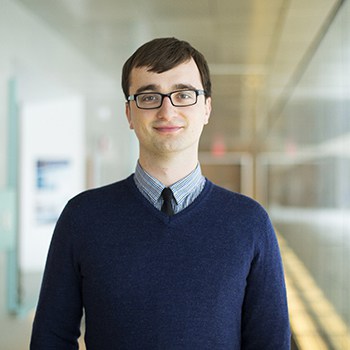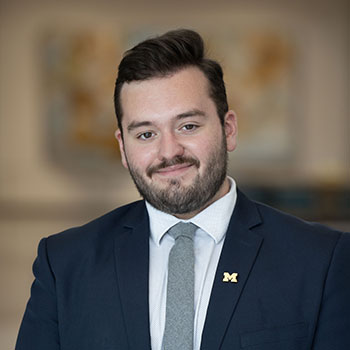
Harnessing Energy to Generate Self-Powered Automated Technology
Goal is to Use Nature’s Energy Against Itself to Protect Infrastructure

Goal is to Use Nature’s Energy Against Itself to Protect Infrastructure
Hurricane-force winds whipping against buildings. Extreme rains deluging swollen rivers and streams. Isolated coastal communities searching for safe, potable drinking water. U-M CEE researchers are studying ways to harness nature’s power and turn it upon itself, innovating new ways to address society’s needs through the Strategic Direction of Automation.

The National Science Foundation (NSF) has awarded a $1.2 million grant to CEE Associate Professors Jeff Scruggs and Branko Kerkez, and two other co-PIs–UM professor Heath Hofmann, Professor of Electrical Engineering and Computer Science, and James Van de Ven, Professor of Mechanical Engineering at the University of Minnesota.
“Many infrastructures, such as buildings, bridges, and water systems, can be made more responsive and resilient against extreme events like earthquakes and storms, through the use of actuators, sensors, and embedded intelligence,” Associate Prof. Scruggs said. “With urban watersheds, for example, control valves and gates enable water to be redirected, in real-time, to reduce the likelihood of floods. In buildings and bridges, we can incorporate various types of force actuators to reduce their deformations during earthquakes and high winds. There are a lot of other examples, too.
These types of technologies are cyber-physical systems, which combine software and decision processes with physical systems. This technology is at the heart of the intelligent systems program in CEE. “It’s all about the idea of embedding sensors, actuators, and decision processes into infrastructures to make them more resilient, more responsive, and more capable of adapting to circumstances,” Prof. Scruggs said.
Automation inherently needs to be powered. “If you talk about equipping infrastructure to protect itself against extreme events, you will have a reliability issue. If your technology is dependent on the same external power grid that is under assault from nature’s forces, you have to engineer a way for it to be reliable in the event it cannot receive power from its regular source,” Prof. Scruggs said.
Because many infrastructures are remote and are not close to a utility to plug in, there is a need to deliver power to remote areas and the need for additional investment required to make that happen. “There’s the possibility of using batteries, but those need to be periodically recharged or replaced, and need to be accessible,” he said. The possibility exists to scavenge energy from the surrounding environment, such as through solar power. However, solar and other environmental power sources may be inadequate for a number of reasons. The amount of energy needed to affect the control can be prohibitively high. Also, in many situations, the sensing and control technologies are deeply embedded in the infrastructure. For example, control systems installed internally in buildings are not applications where solar power would be practical.

In some circumstances, extreme events can impart dynamic loads, such as water currents, wind forces, earthquake accelerations, and ocean waves. ““If we can figure out how to capture the energy involved in these scenarios, we can use it against the loads themselves, to counter their adverse effects,” Prof Scruggs said. For example, if researchers can figure out how to capture and store the energy driven into the building by the wind or an earthquake, they can use this energy against itself to reduce the likelihood of damage.
“Branko and I are working on a similar idea applied to watersheds, which is completely new–nobody has really talked about this before,” Prof. Scruggs added. “Energy harvested from flow through valves and gates would be used to power the actuation of those same valves and gates, along with sensors and wireless communications to coordinate the flow of water through the systems. This type of technology is what we’re calling self-powered technology. Once you set it up, It should operate in perpetuity to replenish itself through stored energy from the disturbances to which it is subjected. It achieves a kind of energy-autonomy that will offer a significant path to lead to the adoption of these technologies.”
The NSF grant will fund the investigation of three types of self-powered infrastructure:
Submerged flaps are available commercially, which are mounted to the ocean floor, for the purposes of wave-driven desalination. When the wave passes, the flap oscillates. The flap is connected to pumps that use the motion of the flap to drive pressurized sea water to shore, where it goes through a reverse osmosis filter and is desalinated. You can build a system that doesn’t require electricity at all; it can be an entirely passive mechanical system. But you can increase the output If you actively control the pump to regulate energy absorbed from the waves. “This is what I am working on with Prof. Van de Ven, from the University of Minnesota,” Prof Scruggs said. “We are developing a technology that captures and stores wave energy, and uses it to power the control system, so that the average rate of pumped water is optimized. It’s a technology that will have application, for example, in isolated coastal communities that need drinking water and are far from heavily-populated areas.”
The NSF grant is for a three-year project, and each of the three areas of research will have experimental testbeds. The intent is not to develop full-scale prototypes, but rather, to demonstrate and validate new concepts. The building will be a miniaturized experiment, and the desalination study will be built in a lab with a simulated flap. “We’re addressing a part of cyber-physical systems and autonomy that’s often taken for granted,” Prof. Scruggs said. “How to deliver energy efficiently, and where that needed energy comes from. It’s not a development grant–it’s an idea grant. Hopefully it will lead to further research, aimed at getting more devices out into the field. With Branko’s part, though, it would be most valuable to deploy in the field. Our hope is to get this done later in the project.”
The watershed aspect of the project does include an additional component. “Branko thinks that we can get more energy out of the water flow than we need to power the pumps, sensors, and control intelligence,” Prof. Scruggs said. “He wants to use the excess power to facilitate water treatment by using electrolysis. That aspect is an extra benefit of the technology. There’s something intellectually satisfying about this challenge,” he said. “There’s a fundamental tradeoff between the secondary objective of capturing as much energy as you can, and the primary objectives, i.e., controlling a building, generating drinkable water, and preventing flooding. In all of the applications we are looking at, the primary and secondary objectives compete with each other. You want to get the best performance possible, without running out of energy. That tradeoff is what makes the problem interesting.”
“For the type of study we need to do, the infrastructure models are pretty well-established, and the kind of thing we teach in our classes. The thing that’s trickier is the modeling of the control technologies–electronics and storage systems. I’ve been investigating this modeling aspect since my doctoral dissertation. There is not a strong appreciation for what is possible. That’s why the experimentation in this area is so important. No one has ever experimentally demonstrated self-powered control in the contexts we’re talking about. From the point of view of gaining acceptance that this is viable, experimentation is key to building that kind of credibility. Experiments are good at convincing people–putting it all together and showing it works establishes credibility.”

Marketing Communications Specialist
Department of Civil and Environmental Engineering